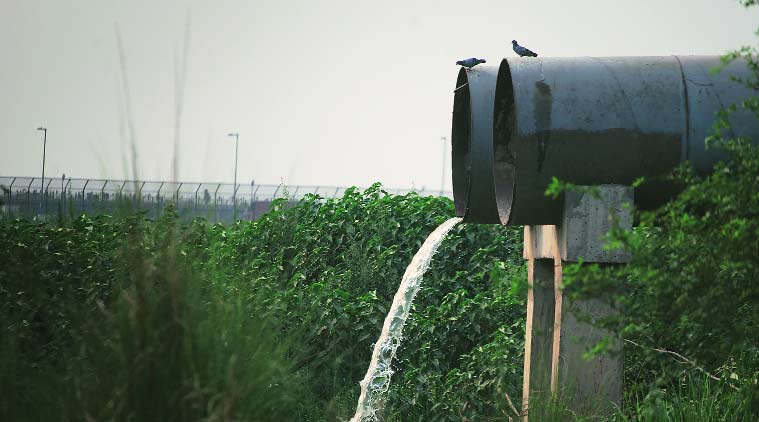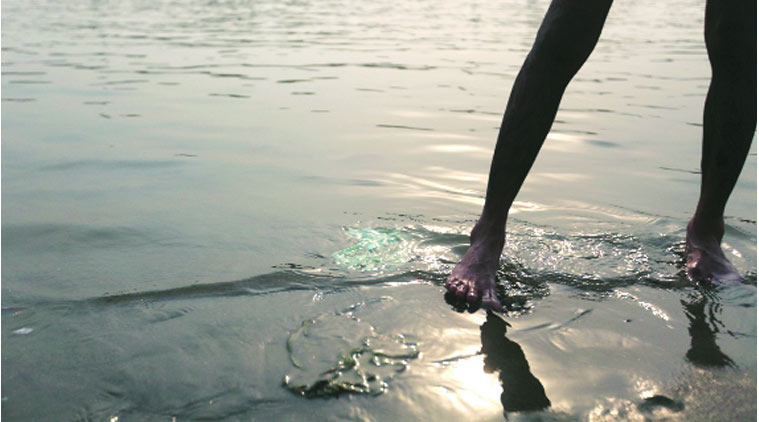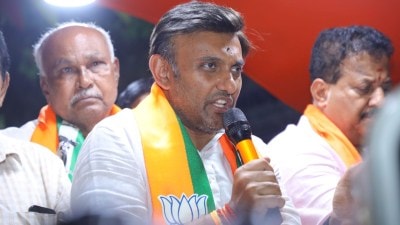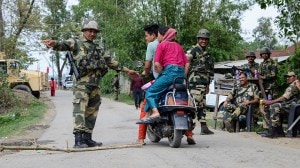- India
- International
Slow death of a river
With various agencies plan and prod one another over its cleaning, flowing Yamuna remains a dream.
 Untreated sewage being released into Yamuna near Wazirabad bridge barrage. (Source: Express Photo by Oinam Anand)
Untreated sewage being released into Yamuna near Wazirabad bridge barrage. (Source: Express Photo by Oinam Anand)Every toilet in Delhi flows straight into the Yamuna, turning it into a public cesspool. While various agencies plan and prod one another over its cleaning, and thousands of crores are spent, a pristine, flowing Yamuna remains a dream. ANIRUDDHA GHOSAL and ADITI VATSA report from its stinking bank
More than Rs 1,500 crore has been spent in the past two decades under the aegis of the Yamuna Action Plan (YAP). The sewage interceptor project — to ensure that only treated sewage is discharged into three drains emptying into the river — cost the Delhi Jal Board (DJB) a total of Rs 1,962 crore. The phase of the National Green Tribunal’s Yamuna revitalisation project is expected to cost another Rs 3,659 crore. But despite optimism, experts, bureaucrats and politicians agree that implementing the Tribunal’s order will be hard.
Manoj Mishra, the petitioner in the case at the Tribunal, explained that the reason previous plans didn’t work was the “obsession with cleaning of water”. He explained, “We need to remember that it is the water flow in the river which is crucial. All rivers have a capacity to clean themselves through their environmental flow. This aspect of river restoration was never explored. For the first time that a judicial body, the NGT in this case, in its January 13 judgment, spoke about ensuring the environmental flow of the river and how it is essential for river restoration.”
[related-post]
He added that another important aspect of the order was to bring the management of sewage, stormwater and industrial waste under one roof. “Stormwater drains are erstwhile tributaries of the river which have now been converted into sewage and toxic drains. Their basic purpose, which was to carry stormwater to the river, was defeated,” he said.
Under the first phase of the NGT’s “Maily Se Nirmal Yamuna’ Revitalisation Project, 2017”, the DJB has been ordered to begin work on 15 STPs that it has to install to deal with the sewage load of Delhi. Presently, only four are operational and one is under construction. An official admitted, “The modalities of the plan are still being worked out. This week we are coming up with an action plan to submit before the NGT.”

 But DJB vice-chairman Kapil Mishra, who is the AAP MLA from Karawal Nagar, said that he was confident of the agency’s ability to execute the plan, while reiterating that in the past the only challenge was that of resources. “In the previous Yamuna Action Plans, there was serious mismanagement of resources. There was no political will. Right now, the NGT has asked the Delhi government and the central government to finance the project. We are in talks with multiple agencies and once we overcome the hurdle of getting resources, the order can be implemented,” he said.
But DJB vice-chairman Kapil Mishra, who is the AAP MLA from Karawal Nagar, said that he was confident of the agency’s ability to execute the plan, while reiterating that in the past the only challenge was that of resources. “In the previous Yamuna Action Plans, there was serious mismanagement of resources. There was no political will. Right now, the NGT has asked the Delhi government and the central government to finance the project. We are in talks with multiple agencies and once we overcome the hurdle of getting resources, the order can be implemented,” he said.
In order to provide the required funds, the NGT has ordered every household generating sewage in the capital to “pay environmental compensation” for cleaning the river. It has also asked Union ministries such as the Ministry of Urban Development to release funds for the project after noting that the DDA has “nearly 281 unauthorised colonies” that contribute heavily to the “generation of sewage” in the capital.
According to Balwinder Kumar, DDA vice-chairman, work on the NGT order has already begun. “The ministry has an urban development fund and the NGT has asked the ministry to release this fund. Meanwhile, we begun the process of demarcation of the river and delineating the boundary of the river and the extent of encroachment. We will submit this to the Tribunal soon,” he said.
While the NGT’s order looks to implement the cleaning of drains through coordinated work by all involved agencies, it was this very multiplicity of agencies that was the greatest problem in cleaning the river in Delhi, explained former CM Sheila Dikshit. “The greatest challenge in Delhi was to clean the many drains that empty into the river of its sludge. As the population increased, so did the pollution in these drains and ultimately the river got very polluted. We tried to do what we could, but the greatest problem lay in the fact that different agencies were working on the same thing,” she said.
According to Dikshit, who was also the chairperson of DJB, the problem was compounded by lack of coordination between different state governments. “It’s not just a question of one state. Delhi had to work alongside the needs and requirements of other states like UP and Haryana,” she said.
Former CPCB member secretary B Sengupta said, “As long as Haryana doesn’t release more water into the Yamuna, this problem will continue. The river needs to have enough water to cleanse itself.”
According to Anumita Roychoudhury of the Centre for Science and Environment (CSE), “The Delhi Government needs to keep in mind the urgency of the issue. Delhi’s groundwater is shrinking rapidly, while at the same time the river is becoming increasingly polluted. The situation needs to be solved immediately.”
 A boy stands on the edge of the river directly opposite the Najafgarh drain. (Source: Express Photo by Oinam Anand)
A boy stands on the edge of the river directly opposite the Najafgarh drain. (Source: Express Photo by Oinam Anand)‘The water is black, it burns the skin’
A little past noon on Sunday, a group of boys plunged into the Yamuna near Wazirabad for a swim. But despite the seeming nonchalance, they take care to not swim downstream of the river, where its waters turn black.
Ajay, a 16-year-old resident of Usmanpur, explained, “The water there is black. The water from the drain flows there and if I swim there, my skin burns.”
The teenager isn’t exaggerating. Sludge from the Najafgarh and supplementary drains ooze out into the river, barely a kilometer downstream of the Wazirabad barrage, turning its waters black and poisonous. “When the drains are fully operational, it becomes impossible to even stand here. Till about 10 years ago, you could fish here. Birds would come in the winters and small animals would come and drink water,” said Rajesh Bhindwani, a resident of Timarpur.
According to the Delhi Jal Board, 63 per cent of the river’s pollution originate from the Najafgarh drain, the supplementary drain and the Delhi Gate drain. Cleaning these two drains up, as priority, is the DJB’s immediate challenge as the first phase of the National Green Tribunal’s (NGT) plan to revitalise the river by 2017.
The NGT order on May 8 talked about restoring the river to its “original pristine and glory”. But standing by the river’s banks, makes it almost impossible to conceive. The acrid smell emanating from the river leaves a metallic taste in the mouth. The water is oily. It’s banks are lined with plastic and other debris. There are barely and birds and no animals.
According to a report filed by CPCB in the NGT, water samples collected from river Yamuna show “flagrant violation” of prescribed standards. Where “the maximum permissible limit of BOD is 3 mg/l, there at the Nizamuddin Bridge, it is 37 mg/1” and “total coliform permissible is 5000 MPN/100 ml, there it is 17,00,00,00,000”, quotes the NGT in its order earlier in January. BOD is commonly used to measure the toxicity of a water body while the presence of coliform bacteria is indicative of the extent of human or animal fecal material present in the water, linked to spread of diseases through fecal transmission.
The reason for the critical pollution levels of the 22-km stretch of Yamuna passing through Delhi is linked to the fact that rarely is any fresh water released into the river from upstream of the Wazirabad barrage. “It’s only possible to clean the Yamuna, when there is hundred per cent cleaning of sewage and when the minimum flow of the river is maintained. Presently, all the fresh water is taken before the Wazirabad barrage for drinking purposes. But even if treated sewage comes back into the river, there needs to be a factor of dilution by ten times before the water can clean itself,” said B Sengupta, former member secretary, CPCB.
He added that the only water being added to the river at Delhi were through the 17 drains that dump copious amounts of waste water into the river. Largest among these is the Najafgarh drain with sewered catchment area of 374 sq kilometre and almost 70 tributary drains that join it, as per CPCB. A total of 17,288 industries from across the capital were recorded by the Delhi Pollution Control Committee, in a study, as industrial units “whose waste waters reaching the Najafgarh drain”.
The other drain that authorities, including the DJB, have been asked to take up as priority as a part of the first phase of the Yamuna revitalisation plan is the Delhi Gate drain. According to Manoj Mishra, of Yamuna Jiye Abhiyan, the petitioner in the case, “This is one of the 22 drains, right next to the Delhi secretariat and flows into the river from there. It’s highly polluted due to a mix cocktail of sewage, unauthorised industrial waste and it also has storm water flowing into it.”
Apr 27: Latest News
- 01
- 02
- 03
- 04
- 05








































